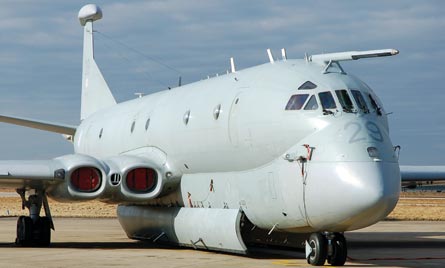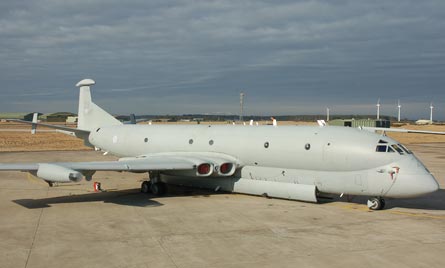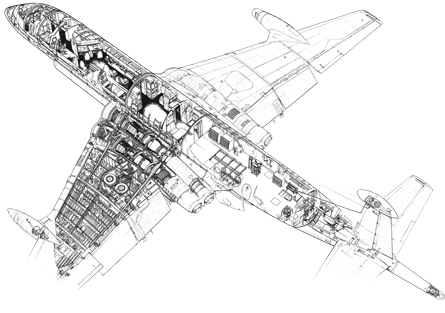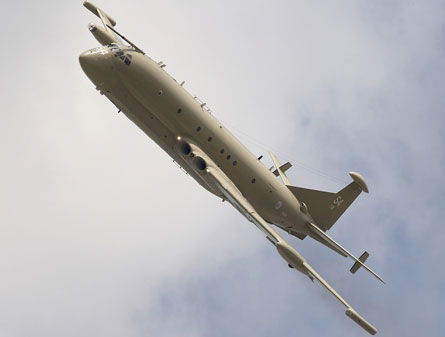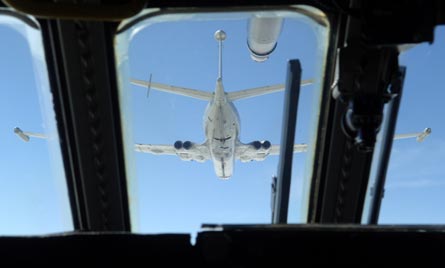The UK Royal Air Force will mark the end of an era in its proud maritime patrol heritage on 31 March, when the last of its British Aerospace Nimrod MR2s will be retired from use.
Commemorated during a formal ceremony at RAF Kinloss in Scotland late last week, the occasion will bring to an end 41 years of operations with the Nimrod: a type derived from the world's first jet airliner, the ill-fated de Havilland Comet, which first flew in 1949.
|
|---|
Having been selected in 1965 to meet the Ministry of Defence's Operational Requirement 381, the original Hawker Siddeley Nimrod arrived at Kinloss from 1970 in its MR1 guise. The first examples entered frontline use the following year, replacing the RAF's venerable Avro Shackleton.
Shortly after entering service, the bulk of the new Nimrods were upgraded to the MR2 standard, with the model beginning activities in 1979. In total, 34 of the original aircraft were modified, while one new-build MR2 was also introduced.
The Nimrod's primary responsibility was to provide anti-submarine warfare (ASW) cover for the UK, and to deliver a new long-range search and rescue capability in support of military vessels and commercial shipping.
The type was also armed with torpedoes, enabling it to conduct anti-surface warfare missions if required, with a large internal weapons bay. However, this was ordinarily used only to carry emergency equipment, such as life rafts, to be dropped in support of stricken vessels.
Powered by four Rolls-Royce Spey turbofans each capable of generating over 12,100lb (55kN) of thrust, the Nimrod had an impressive maximum speed of 500kt (925km/h) and an unrefuelled mission endurance of around 9h. Such characteristics set the "Mighty Hunter" a class apart from its turboprop rivals in the maritime patrol market.
The aircraft's design traits were swiftly put to the test, with the Nimrod force soon called upon to support UK forces during the Falklands War of 1982.
Rapidly given the ability to be refuelled in flight by the RAF's Handley Page Victor tankers, MR2s supported operations "down south" from Ascension Island in the mid-Atlantic. The Nimrod force's commitment included flying in support of the audacious Black Buck missions conducted by the RAF's Avro Vulcan bombers. In one instance, a Nimrod remained airborne for 18h and 50min, during which time it established a distance record of over 8,450 miles (13,600km) which still stands for a single maritime patrol mission.
|
|---|
Over the following two decades, the UK's Nimrods demonstrated their operational flexibility, by also serving during coalition campaigns in the Balkans, Iraq and Afghanistan. The fleet also received the ability to perform overland surveillance tasks in support of the last two conflicts, transforming the utility of an asset that was facing a reduced submarine threat closer to home.
"One of the fantastic things about the MR2 has been its adaptability," says Kinloss station commander Gp Capt Robbie Noel. "The platform has got persistence, a range of different sensors and an extensive communications suite, but you've also got a crew on board. With that number of people you can conduct a number of different tasks concurrently."
The period between 2001 and 2009 saw MR2s used to conduct simultaneous activity above Iraq and Afghanistan, as well as contributing to the maritime security mission in support of the USA's Operation Enduring Freedom in the Middle East. They were also still flying ASW, maritime counter-terrorism and counter-narcotics sorties as required in the UK. "That integrity of the UK maritime area consumed a huge amount of energy and effort in hours, from a crew and ground crew perspective," Noel says.
Support for the Afghanistan campaign started in October 2001, with MR2s initially serving in a communications rebroadcast role. The aircraft was subsequently equipped with an L-3 Wescam MX-15 electro-optical/infrared surveillance camera under an urgent operational requirement deal. This saw the aged type become a highly valued part of the UK's deployed intelligence, surveillance, target acquisition and reconnaissance capability, despite lacking the datalinks found on more modern platforms.
Installed beneath the aircraft's starboard wing, the MX-15 sensor provides images in three formats: wide and narrow electro-optical, and infrared. An operator position for the equipment was placed next to the aircraft's acoustics stations, and includes a moving map function. In Afghanistan, this was used to slew the sensor on to co-ordinates provided by a forward air controller.
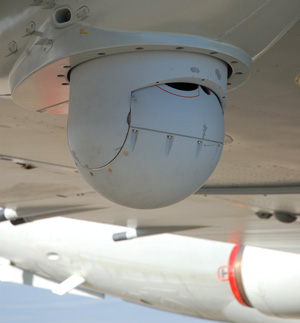 |
|---|
The MX-15 sensor has also been installed on other RAF assets. Photo: Craig Hoyle/Flightglobal |
"The time from information to eyes on target is seconds," says Master Air Crew Keith Treece. "The difference between the Nimrod and a UAV [unmanned air vehicle] is that we can take a liaison officer up with the aircraft to interpret that knowledge," he adds.
The modified aircraft were also in the region for the start of the second Gulf War in 2003, when they operated over Iraq's western desert in support of types such as the UK's BAE Systems Harrier GR7s while hunting for Scud missile launchers. Sorties would typically last around 8h, but with tanker support could be extended to 13-14h.
Noel says around a quarter of the Nimrod force's personnel were deployed overseas during this time. "We went through a period of intense operational tempo, where every crew and every member of the ground crew deployed at one time or another to the Middle East," he adds.
But the sustained high pace of activity with the MR2 eventually took its toll, and on 2 September 2006 aircraft XV230 was lost in Afghanistan following a mid-air explosion that happened shortly after refuelling from an RAF Lockheed TriStar tanker. Fourteen British personnel died in the incident, the largest single loss of life suffered by the UK in Afghanistan since 2001.
Originally due to have left service several years before the crash, the Nimrod aircraft came under intense public scrutiny following the publication of a Board of Inquiry report into the accident. This found that a fundamental design flaw with the Nimrod's fuel system, combined with the hastily performed air-to-air refuelling modification made for the Falklands conflict, had combined to destroy VX230. A catastrophic fire broke out as overflowing fuel came into contact with super-heated hot air ducts.
|
|---|
The type remained in deployment following the accident, but was no longer allowed to undergo in-flight refuelling. But it was eventually withdrawn from theatre in May 2009 for a fleet-wide safety modification. By now reduced to 11 aircraft, each aircraft in the RAF's inventory received new hot air ducts and some replacement fuel seals under a project worth around £16 million ($23.8 million).
Explaining the timing of the withdrawal decision, Noel says: "The reason why you can withdraw MR2 from the order of battle for Operation Herrick [the UK's contribution to the NATO-led mission in Afghanistan] is that you've got other platforms that can conduct the same task, and some of them better." Examples include the General Atomics Reaper remotely piloted aircraft, the Raytheon Systems Shadow R1 - a modified Beechcraft King Air 350ER - and the airborne stand-off radar system, using the Sentinel R1 airframe developed from Bombardier's Global Express business jet.
"You've got a really potent mix of ISTAR assets that can deploy today that we didn't have when the MR2 was filling the gap," Noel says.
Accordingly, Nimrods from Kinloss did not return to the Middle East as planned, and UK defence secretary Bob Ainsworth announced last December that the MR2's removal from service had been accelerated by one year from March 2011. The action was taken in parallel with a decision to delay the introduction of BAE Systems' replacement Nimrod MRA4, in an effort to save money and address a massive hole in the UK's strained defence budget.
"The decision to retire MR2 12 months early and to slow the introduction of MRA4 was made so that we can better support those troops on the ground in Afghanistan," says Noel. He describes the decision as a "conscious risk", as UK search and rescue cover will have to be provided by using a mix of RAF Lockheed Martin C-130 transports and Royal Navy AgustaWestland AW101 Merlin HM1 helicopters.
"There is no doubt at all in my mind that there will be some capability gaps throughout that period of transition," he says.
Equally, the removal of the Nimrod MR2 will leave a gap in the UK's ability to monitor submarine movements. "The Russians have been upping the ante recently, but we've been keeping up", notes 120 Sqn Master Air Crew Jake Thackeray, who will soon transition on to the MRA4 in the new role of information manager.
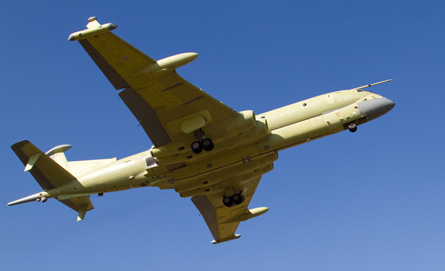 |
|---|
An 18-month gap until the entry into service of the RAF's new Nimrod MRA4 has been accepted as a "conscious risk". Photo: BAE Systems |
The MR2's pedigree as a submarine hunter, which includes the early use of acoustics equipment originally purchased for the long-delayed MRA4, plus Thales's Searchwater radar, has been demonstrated by numerous wins of the international Fincastle Trophy. And in a recent exercise conducted from Sicily with US Navy Lockheed P-3C Orions, the UK aircraft found eight submarines for every one located by their counterparts.
The RAF and the USN share a common vision for their next-generation MPA, with both the Nimrod MRA4 and the Boeing 737-based P-8A Poseidon to be honed purely for the anti-submarine mission. With the demands of overland surveillance having taken precedence over the last decade, another UK crew member notes: "Everybody's losing the edge in ASW because they've been operating over the desert."
The rundown of the Nimrod MR2 fleet saw the UK's remaining aircraft being operated by 10 crews from the RAF's 120, 201 and 42(R) squadrons. Many of these personnel are set to soon make the transition to the MRA4, and all three units are expected to remain in existence in support of the new type.
With operational use also greatly reduced following the retirement decision, the so-called "depth" maintenance facility for the MR2 at Kinloss has already been closed, with personnel from civilian contractor Cobham having left. Support for the legacy type was delivered at the base under BAE's Nimrod integrated support contract, and Noel praises the way in which this has worked.
"One of the great strengths of the Nimrod force has been the relationship with the company," he says. "Like any relationship there will be strains placed upon it, but my commitment, alongside my BAE counterparts, has been to ensure that we see the challenges from each others' perspective, and find that middle ground."
Similar in-service support arrangements for the new aircraft are not in place, with "the location of depth maintenance for the MRA4 yet to be determined", he confirms. Noel meanwhile dismisses persistent rumours of a possible relocation of the new fleet to RAF Waddington in Lincolnshire, noting that such an action would incur prohibitively high costs. "Kinloss is not being mothballed," he says. "We will just be having an enforced slow-down in flying."
A lasting memorial to the MR2 force and to those killed while operating the Nimrod is now in place at the Scottish base, with aircraft XV240 having been installed as a gate guardian at the site last September, following its retirement. Like the majority of the remaining fleet, the aircraft had logged more than 19,000 flight hours at the end of its life.
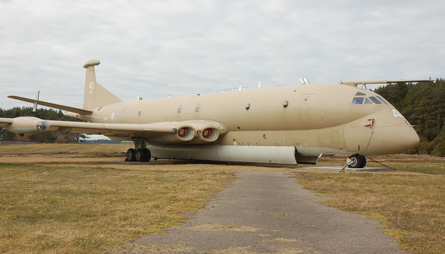 |
|---|
XV240 has been retained at Kinloss as a gate guardian. Photo: Craig Hoyle/Flightglobal |
Other events to mark the MR2's retirement also included a late March visit to Gibraltar by one of the last examples, and a "round-robin" flight passing over Nimrod-linked sites in the UK before a 26 March ceremony at Kinloss. And several more flights are due to be performed by 42 Sqn personnel following the 31 March deadline, with around six aircraft likely to be delivered to museums around the UK, at a rate of roughly one a week.
Although its last MR2s will have been silenced, the Nimrod will carry on in RAF service in the near term, with the R1 electronic intelligence variant to remain operational with its 51 Sqn at Waddington until March 2011. The type will be replaced by three Boeing RC-135 Rivet Joints, ironically derived from the world's second jet airliner, the Boeing 707, from 2014.
Historically a low-profile asset, the Nimrod R1 capability became public knowledge after the textbook ditching of aircraft XW666 in the Moray Firth in May 1995 following an engine fire. An MR2, XV249, was converted to replace the lost asset and restore the service's then three-strong fleet of the type.
In addition to serving in the maritime patrol aircraft role in the MR1 and MR2 guises for over 40 years, the Nimrod airframe was also adapted for another mission, but with significantly less success.
The name Nimrod became synonymous with procurement malaise during the 1980s, when efforts to adapt the type for the airborne early warning mission failed spectacularly. The disastrous Nimrod AEW3 project was finally axed after the UK had spent roughly £1 billion, and the 11 MR1s already converted or allocated for the programme eventually went for scrap.
This troubled activity was then followed by the 1996 selection of the "Nimrod 2000" to satisfy the UK's replacement MPA requirement. Later rebranded as the MRA4, the project has suffered lengthy delays and major cost increases, while the size of the intended fleet has fallen from an original commitment for 21 aircraft to just nine.
Despite its past problems, the new type is now close to delivering at last, with two production aircraft having flown and the MRA4 due to resume the operational legacy of the UK's "Mighty Hunter" from 2012.
|
|---|
NIMROD MARITIME PATROL AIRCRAFT - OVER 40 YEARS OF DUTY
1965
Comet airliner-derived Hawker Siddeley Nimrod MR1 selected for UK Operational Requirement 381
1970
First Nimrod MR1 arrives at RAF Kinloss
1971
Nimrod MR1 enters frontline use with RAF
1979
First converted Nimrod MR2, XV236, arrives at RAF Kinloss
1980
Nimrods respond to Alexander Kielland oil rig collapse, which kills 123 people
XV256 crashes after suffering multiple birdstrikes on take-off from Kinloss, killing both pilots
1982
Nimrod MR2 makes combat debut during Falklands War, after conversion for in-flight refuelling
Endurance record established during 18h 50min sortie
|
|---|
1985
Nimrod locates Virgin Atlantic Challenger after Richard Branson's failed Blue Riband record attempt
1988
Nimrods co-ordinate search and rescue response to Piper Alpha oil rig disaster
1990
Nimrod MR2s deploy to Middle East ahead of first Gulf War with Iraq
1992
Nimrod force starts five-year commitment to enforcing UN sanctions against the former Yugoslavia
1995
Seven-man crew of XV239 lost after it stalls and crashes at Toronto air show
1996
MoD selects Nimrod 2000 for 21-aircraft RMPA requirement, rejecting P-3 Orion-based offer
2001
Nimrod MR2 deployed to support maritime interdiction operations off Iraq
2006
Nimrod supports evacuation of British nationals from Lebanon
Fourteen British personnel killed as XV230 explodes over Afghanistan after in-flight refuelling
2009
RAF cuts MR2 fleet from 14 to 11 aircraft
Nimrod MR2s withdrawn from overseas operations for safety modifications
Nimrod supports deployment of Eurofighter Typhoons to the Falkland Islands
Ministry of Defence announces decision to accelerate MR2's retirement by one year
2010
31 March RAF retires last Nimrod MRs after a service career spanning 41 years
Source: Royal Air Force
RELATED
IN THE ARCHIVE
- 3 October 1967 Test flying the Nimrod
- 12 March 1977 Rolling out the Nimrod
- 20 November 1976 AEW Nimrod gets into top gear
- 23-29 July 2002 Technical description: Reborn in old skin - BAE has spent the past six years updating the Nimrod maritime patrol aircraft to modern standards. But how much of the original airframe remains?
- More about the Nimrod...
Source: Flight International





















